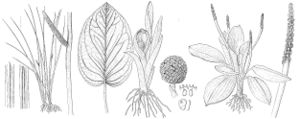Orontium aquaticum
Sp. Pl. 1: 324. 1753.
Roots contractile. Rhizomes 1.5–3 cm diam. Leaves: petiole dark green to red-green, 10–40(–60) cm; blade (6–)10–30(–45) cm, about ±1/3 as wide (greater than 3 cm wide), main veins from base, curving apically parallel to midvein. Inflorescences: spadix bright yellow, 2–10 cm × 5–10 mm, apex rounded. Flowers covering spadix; tepals (2–)6, arched over ovaries, yellow; stamens (2–)6, sometimes with 1 or 2 staminodes; ovaries 1-locular, ovules 1. Fruits 1–2 cm diam.; pericarp thin. Seeds 1–1.5 cm diam.; endosperm absent; germinating soon after falling from parent plant. 2n = 26.
Phenology: Flowering late winter (s range)�spring.
Habitat: Shallow water of bogs, marshes, swamps, and streams
Elevation: 0–900 m
Distribution

Ala., Conn., Del., D.C., Fla., Ga., Ky., La., Md., Mass., Miss., N.J., N.Y., N.C., Pa., R.I., S.C., Tenn., Tex., Va., W.Va.
Discussion
Orontium aquaticum is probably the most distinctive species of Araceae growing in North America. It is the only species that does not have a spathe, and the characteristic blue-green velvety leaves are not easily confused with those of any other plants. The unique appearance of the leaf blade of O. aquaticum is partly because of the waxy epidermal layer, which readily sheds water. The leaves also have large intercellular air spaces that contribute to their buoyancy.
Specimens of Orontium aquaticum supposedly collected in Iowa are almost certainly a labeling error. Populations occur primarily on the Atlantic and Gulf coastal plains and less frequently in the Appalachian region.
Orontium aquaticum and Peltandra virginica may have been used somewhat interchangeably by Native Americans and may be confused at times in the literature. Seeds of O. aquaticum were either dried or boiled repeatedly in water before being eaten by Native Americans; Swedish settlers also used the seeds in a similar manner (P. Kalm 1770–1771). Fresh seeds microwaved for 5 minutes in tap water have a "firm texture and pleasant, nutty flavor" and produce no irritation (L. H. Klotz 1992). Orontium aquaticum is sometimes grown for its attractive foliage and bright yellow spadices in aquatic gardens. It is available through catalog sources.
Selected References
None.
